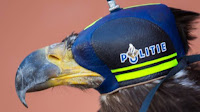Yahoo – AFP, Adel Zaanoun, September 4, 2016
 |
A Palestinian volunteer trains a stray dog at the Al-Soulala Association for
Protection, Rehabilitation and Training, dog shelter in central Gaza Strip (AFP
Photo/Mohammed Abed) |
Gaza City
(Palestinian Territories) (AFP) - In an impoverished and war-battered territory
suffering food shortages and a scarcity of jobs, Saeed al-Ar knew it was a tall
order opening a dog shelter in Gaza.
The
Palestinian coastal enclave crammed with 1.9 million people has been devastated
by three wars against Israel since 2008, and it remains under blockade by the
Jewish state and Egypt.
The fate of
hundreds of stray dogs outside towns or near the Israeli security fence have
been anything but a priority.
"How
can we create a shelter for strays when we need shelter ourselves?" is the
typical view, as expressed by a 27-year-old unemployed Gazan, Jasser al-Sheikh.
"We
must first feed our children and find jobs for thousands of unemployed
graduates."
But Ar, a
45-year-old father of seven, has taken it upon himself to intervene, spending
his own money to rescue the strays.
Last month,
he opened the territory's first dog sanctuary in a relatively well-off suburb
south of Gaza City.
His
Al-Soulala Association for Protection, Rehabilitation and Training covers 2,700
square metres (29,000 square feet), complete with kennels which currently house
around 75 former strays.
 |
Saeed al-Ar
used his own money to set up the Al-Soulala Association for
Protection,
Rehabilitation and Training, dog shelter in central Gaza Strip (AFP
Photo/Mohammed Abed)
|
Behind
beige tarpaulin on a vast sandy expanse, dogs are fed and given training to run
and jump obstacles.
"This
is the first kennel in Palestine that supports stray dogs and domesticates
them," Ar told AFP.
He used to
run a police unit for dogs specialising in the detection of explosives and
drugs, and admits that canines have always been his passion.
When the
Islamist movement Hamas seized power in Gaza in 2007, Ar found himself out of a
job. But he still collects a salary and now dedicates all his time to the dogs.
Shot or
poisoned
In the
predominantly Muslim territory, religious authorities consider dogs to be
unclean or impure.
Some Gazans
even shoot at stray dogs that approach their children or orchards, while others
find them scary and blame them for accidents.
The
authorities lack the resources even if they were inclined to intervene.
In the past
they even tried to poison strays, but stopped the culling over concerns that it
was also dangerous to humans, a municipal official said on condition of
anonymity.
The kennel
aims to catch stray dogs, provide veterinary services and help domesticate
them.
Since its
opening, the kennel has attracted a growing number of visitors, many of them
children. Some have asked to adopt a pet, a trend picking up in Gaza.
The phone
rings constantly with people reporting strays in their neighbourhood.
In such
cases, search teams are sent out, said Mohammed al-Hindi, 24, a recently
graduated nurse and one of 25 volunteer helpers.
Every
morning, the volunteers tour participating restaurants and stores to collect
leftover meat and chicken for the dogs, in a sign of changing attitudes in
Gaza.
But Ar said
he has already spent $35,000 and cannot make ends meet on his own much longer.
The centre
needs $5,000 a month to function properly, said Ar, who has launched an online
appeal to animal protection groups and lovers across the world.
"We
have to get help because at the moment we are doing this with our own
money."
On a
brighter note, he said local authorities have promised him a larger plot of
land. He dreams of a giant kennel, "with a dog food factory and a
veterinary clinic for all stray animals".












